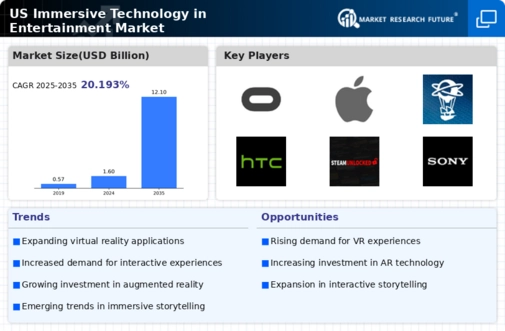The US Immersive Technology in Entertainment Market has been experiencing rapid evolution and development, driven by advancements in virtual reality (VR), augmented reality (AR), and mixed reality (MR) technologies. As consumer demand for immersive experiences continues to grow, key players in the market are leveraging innovative hardware and software solutions to gain competitive advantages. This landscape is characterized by a variety of companies striving to establish their dominance through unique offerings, strategic collaborations, and investment in research and development.
The market is not only about delivering state-of-the-art technological experiences but also about understanding and predicting consumer behavior to create products that resonate with a broad audience.
Valve has emerged as a significant player within the US Immersive Technology in Entertainment Market, known for its strong presence and influential role in shaping the VR landscape through its hardware and platforms. The company has established a well-recognized reputation through its flagship product, the Valve Index, which provides users with a high-fidelity virtual reality experience. Valve's strengths lie in its innovative approach to immersive technology, complemented by a focus on community-driven content and extensive support for VR developers. This focus has enhanced its appeal in the US market, allowing the company to build a loyal user base.
Furthermore, Valve's continuous engagement with game developers and investment in user-friendly interfaces have solidified its position in the competitive arena, while its effective management of the Steam platform provides a valuable distribution channel for immersive content, driving further growth.
Oculus, a leader in the US Immersive Technology in Entertainment Market, is integral to the industry with its compelling range of products and services. As a subsidiary of a leading tech conglomerate, Oculus focuses on providing accessible and enjoyable VR experiences through its headsets, such as the Oculus Quest and Rift series. The company's strengths include a comprehensive ecosystem that integrates gaming, social interaction, and educational content, appealing to a diverse audience. Oculus's market presence is underscored by strategic partnerships, developing key collaborations with game developers and entertainment companies to enrich its library of immersive experiences.
The company's commitment to innovation is evident through regular software updates and new feature introductions. Mergers and acquisitions have also played a crucial role in Oculus's growth trajectory, allowing it to enhance its technology and expand its offering in the US market. Through these strategies, Oculus has succeeded in creating a robust position in the competitive landscape of immersive entertainment.

























Leave a Comment